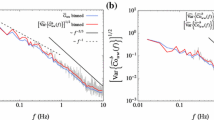Abstract
THE observations on the low-frequency or ‘slow tail’ component in the waveform of an atmospheric described recently by Hepburn and Pierce in Nature1 is of particular interest to us since we have been making similar observations for some years. The earlier observations made by Appleton and Chapman2 dealt with the evolution of atmospheric waveforms. It was shown that many atmospherics consist of an oscillatory portion, composed of a sequence of quasi half-cycles of increasing duration, followed by a ‘slow tail’ of usually two rounded half-cycles. The oscillatory portion was found to move ahead of the slower disturbance as the distance of propagation increased. Further, the quasi half-period of the components of the oscillatory portion was found to obey a relation different from the ‘slow tail’.
Similar content being viewed by others
References
Hepburn, F., and Pierce, E. T., Nature, 171, 837 (1953).
Appleton, E. V., and Chapman, F. W., Proc. Roy. Soc., A, 158, 1 (1937).
Chapman, F. W., and Edwards, A. G., Proc. U.R.S.I., 8, Pt. 2, 351 (1950).
Watson-Watt, R. A., Herd, J. F., and Lutkin, F. E., Proc. Roy. Soc., A, 162, 267 (1937).
Author information
Authors and Affiliations
Rights and permissions
About this article
Cite this article
CHAPMAN, F., MATTHEWS, W. Audio-Frequency Spectrum of Atmospherics. Nature 172, 495–496 (1953). https://doi.org/10.1038/172495a0
Issue Date:
DOI: https://doi.org/10.1038/172495a0
- Springer Nature Limited
This article is cited by
-
On the propagation of long and very long radio waves around the earth
Il Nuovo Cimento (1962)
-
Very Low-Frequency Spectra of Atmospherics Propagated through the Ionosphere
Nature (1959)
-
Propagation of Audio-Frequency Radio Waves to Great Distances
Nature (1956)





